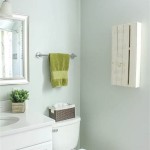What to Put Under Vinyl Flooring in the Bathroom
When installing vinyl flooring in a bathroom, it's important to consider what you will put underneath it. The right underlayment can help improve the comfort, sound insulation, and longevity of your new floor. Here are a few options to consider:
1. Cork Underlayment
Cork is a natural material that provides excellent thermal and sound insulation. It is also mildew-resistant, making it a good choice for bathrooms. Cork underlayment is available in different thicknesses, so you can choose the one that best suits your needs. However, it's important to note that cork underlayment can be more expensive than other options.
2. Rubber Underlayment
Rubber underlayment is another good choice for bathrooms. It is waterproof, mold-resistant, and provides good sound insulation. Rubber underlayment is also relatively easy to install. However, it can be more expensive than some other options.
3. Foam Underlayment
Foam underlayment is a budget-friendly option that is easy to install. It provides some cushioning and sound insulation but not as much as cork or rubber underlayment. Foam underlayment is not waterproof, so it is not the best choice for bathrooms that are prone to moisture.
4. Radiant Heat Underlayment
Radiant heat underlayment is a great option for bathrooms that have radiant heat flooring. It helps distribute the heat evenly and can make the floor more comfortable to walk on. Radiant heat underlayment is typically made of polyethylene or polystyrene.
5. Self-Leveling Underlayment
Self-leveling underlayment is a type of underlayment that can be used to level out uneven floors. It is made of a self-leveling compound that flows into the low spots in the floor, creating a smooth, level surface. Self-leveling underlayment can be used under any type of flooring, including vinyl.
Additional Considerations
In addition to the type of underlayment, there are a few other factors to consider when choosing what to put under vinyl flooring in the bathroom:
- Moisture resistance: The underlayment should be moisture-resistant to prevent water damage to the floor.
- Sound insulation: If you are concerned about noise, choose an underlayment that provides good sound insulation.
- Thickness: The thickness of the underlayment will affect the overall thickness of the floor. Choose a thickness that is appropriate for your needs.
- Cost: Underlayment can range in price from a few cents per square foot to several dollars per square foot. Choose an option that fits your budget.
By considering these factors, you can choose the best underlayment for your vinyl flooring installation in the bathroom.

Vinyl Planks In Bathrooms Residential Inspiration Flooring

How To Lay Vinyl Floor In A Bathroom Dove Cottage

Can You Renovate Bathrooms With Vinyl Flooring Imagine Floors

How To Install Sheet Vinyl Floor Decor Adventures

Can Vinyl Flooring Be Used In A Bathroom Hallmark Floors

Dos And Don Ts For Installing Vinyl Plank Floors In The Bathroom Advice Homeowners

7 Benefits Of Bathroom Vinyl Flooring Victorian Plumbing

How To Install Vinyl Plank Flooring In A Bathroom Fixthisbuildthat

Installing Vinyl Plank Flooring Lifeproof Waterproof Rigid Core Sustain My Craft Habit

Installing Vinyl Plank Flooring Lifeproof Waterproof Rigid Core Sustain My Craft Habit







